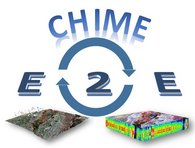Copernicus Hyperspectral Imaging Mission for the Environment (CHIME)

Funding by: ESA
Funding ID: 4000125505/18/NL/IA
Project executing or management agency: ESA
Funding period: 01.09.2018 - 31.12.2020
The main objective of this project is to develop an end-to-end (E2E) satellite simulator framework for the Copernicus Hyperspectral Imaging Mission for the Environment (CHIME). CHIME is currently a candidate mission in the Copernicus Expansion Sentinel program. The simulator that is developed in the frame of this study generate realistic and synthetic CHIME data sets at raw data level (L0) in forward mode. It creates L1B, L1C and L2A products, together with bio-geophysical parameters (L2B), in backward mode by applying subsequent processing steps. Moreover, a range of sites and ecosystems comprising CHIME's raw material and sustainable agricultural management foci are covered by the simulations, which also include large spatial areas (up to 180 km) as needed for this hyperspectral wide-swath mission solutions.
The developed E2E Performance Simulator is composed of different modules including:
- Geometry Module (GM): simulates the orbit, attitude and line-of-sight of the sensor.
- Scene Generator Module (SGM): simulates the scene to be recorded by CHIME including all environmental effects to be considered for the generation of TOA radiance.
- Optical Performance Simulator (OPSI): simulates the instrument’s behavior and the subsequent L0/L1 processing chain.
- L2 Ground Processing Prototype Processor Module (L2GPP): is responsible for the atmospheric correction.
- L2B Processor Module (L2B): creates typical CHIME products from surface reflectance values
- Performance Assessment Module (PAM): evaluates statistically the performance of two independent sensor concepts based on L1B, L1C, L2A and L2B products
Three separate L2B processors are developed to retrieve vegetation, soil and mineral parameters respectively from a list of CHIME core parameter products, defined by the Mission Advisory Group (MAG). For this purpose different test scenes are generated for all individual parameters and adequate retrieval algorithms implemented in the L2B processors that enable a meaningful sensor performance assessment. This part is supported by CHIME campaign activities and the availability of consolidated ATBDs in the timeframe of Phase A/B1.



